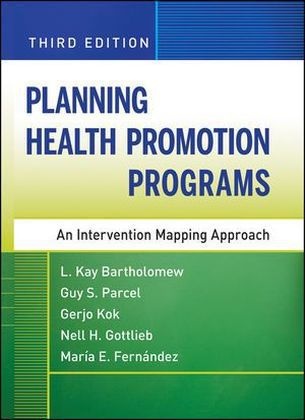Read more
Informationen zum Autor L. Kay Bartholomew, EdD, MPH, is associate professor of health promotion and behavioral sciences and associate dean for academic affairs at the University of Texas School of Public Health.Guy S. Parcel, PhD, is former dean and professor in health promotion and behavioral science at the University of Texas Health Science Center at Houston, School of Public Health.Gerjo Kok, PhD, is former dean and professor of applied psychology at the faculty of psychology at Maastricht University, The Netherlands.Nell H. Gottlieb, PhD, is professor of health education in the department of kinesiology and health education at the University of Texas at Austin.MarÍa E. Fernández, PhD, is associate professor of health promotion and behavioral sciences and director of diversity programs at the University of Texas Health Science Center at Houston, School of Public Health. Klappentext Planning Health Promotion ProgramsThis thoroughly revised and updated third edition of Planning Health Promotion Programs provides a powerful, practical resource for the planning and development of health education and health promotion programs.At the heart of the book is a streamlined presentation of Intervention Mapping, a useful tool for the planning and development of effective programs. The steps and tasks of Intervention Mapping offer a framework for making and documenting decisions for influencing change in behavior and environmental conditions to promote health and to prevent or improve a health problem.Planning Health Promotion Programs gives health education and promotion professionals and researchers information on the latest advances in the field, updated examples and explanations, and new illustrative case studies. In addition, the book has been redesigned to be more teachable, practical, and practitioner-friendly. Zusammenfassung Planning Health Promotion ProgramsThis thoroughly revised and updated third edition of Planning Health Promotion Programs provides a powerful, practical resource for the planning and development of health education and health promotion programs.At the heart of the book is a streamlined presentation of Intervention Mapping, a useful tool for the planning and development of effective programs. The steps and tasks of Intervention Mapping offer a framework for making and documenting decisions for influencing change in behavior and environmental conditions to promote health and to prevent or improve a health problem.Planning Health Promotion Programs gives health education and promotion professionals and researchers information on the latest advances in the field, updated examples and explanations, and new illustrative case studies. In addition, the book has been redesigned to be more teachable, practical, and practitioner-friendly. Inhaltsverzeichnis Figures, Tables, and Exhibits.Acknowledgments.The Authors.Part One Foundations.One Overview of Intervention Mapping.Two Behavior-Oriented Theories Used in Health Promotion.Three Environment-Oriented Theories.Part Two Intervention Mapping Steps.Four Intervention Mapping Step 1: Needs Assessment.Five Intervention Mapping Step 2: Preparing Matrices of Change Objectives.Six Intervention Mapping Step 3: Selecting Theory-Informed Intervention Methods and Practical Applications.Seven Intervention Mapping Step 4: Producing Program Components and Materials.Eight Intervention Mapping Step 5: Planning Program Adoption, Implementation, and Sustainability.Nine Intervention Mapping Step 6: Planning for Evaluation.Ten Using Intervention Mapping to Adapt Evidence-Based Programs to New Settings and Populations.References.Index....
List of contents
Figures, Tables, and Exhibits.
Acknowledgments.
The Authors.
Part One Foundations.
One Overview of Intervention Mapping.
Two Behavior-Oriented Theories Used in Health Promotion.
Three Environment-Oriented Theories.
Part Two Intervention Mapping Steps.
Four Intervention Mapping Step 1: Needs Assessment.
Five Intervention Mapping Step 2: Preparing Matrices of Change Objectives.
Six Intervention Mapping Step 3: Selecting Theory-Informed Intervention Methods and Practical Applications.
Seven Intervention Mapping Step 4: Producing Program Components and Materials.
Eight Intervention Mapping Step 5: Planning Program Adoption, Implementation, and Sustainability.
Nine Intervention Mapping Step 6: Planning for Evaluation.
Ten Using Intervention Mapping to Adapt Evidence-Based Programs to New Settings and Populations.
References.
Index.

